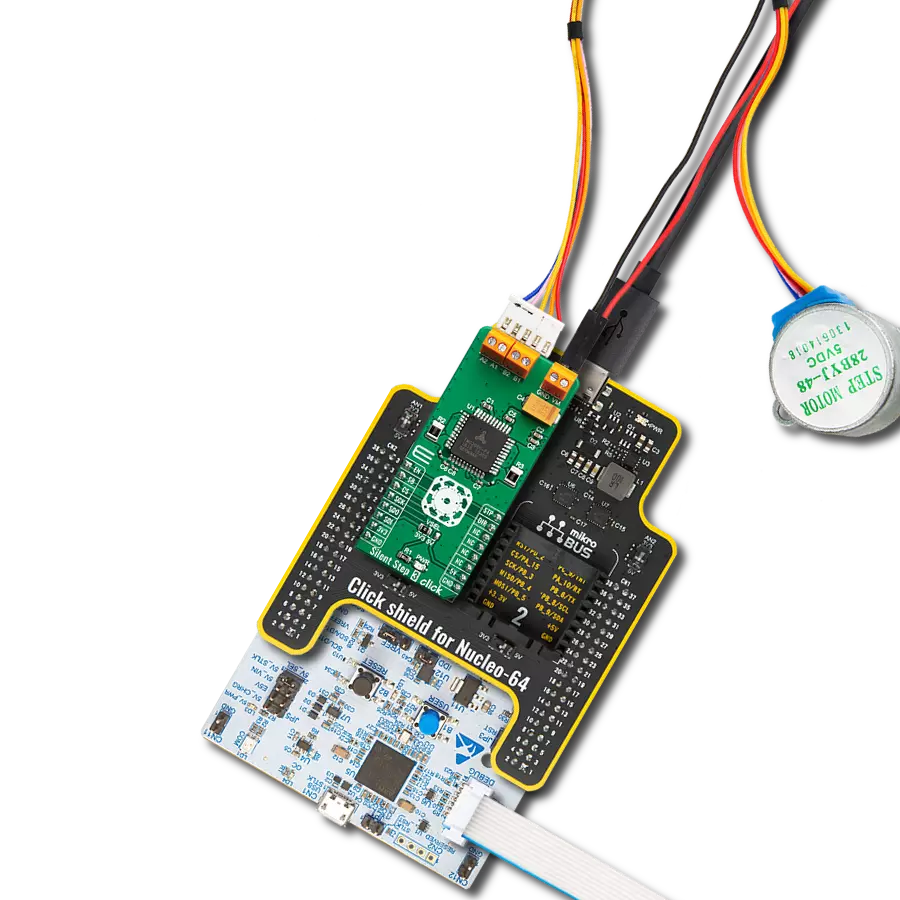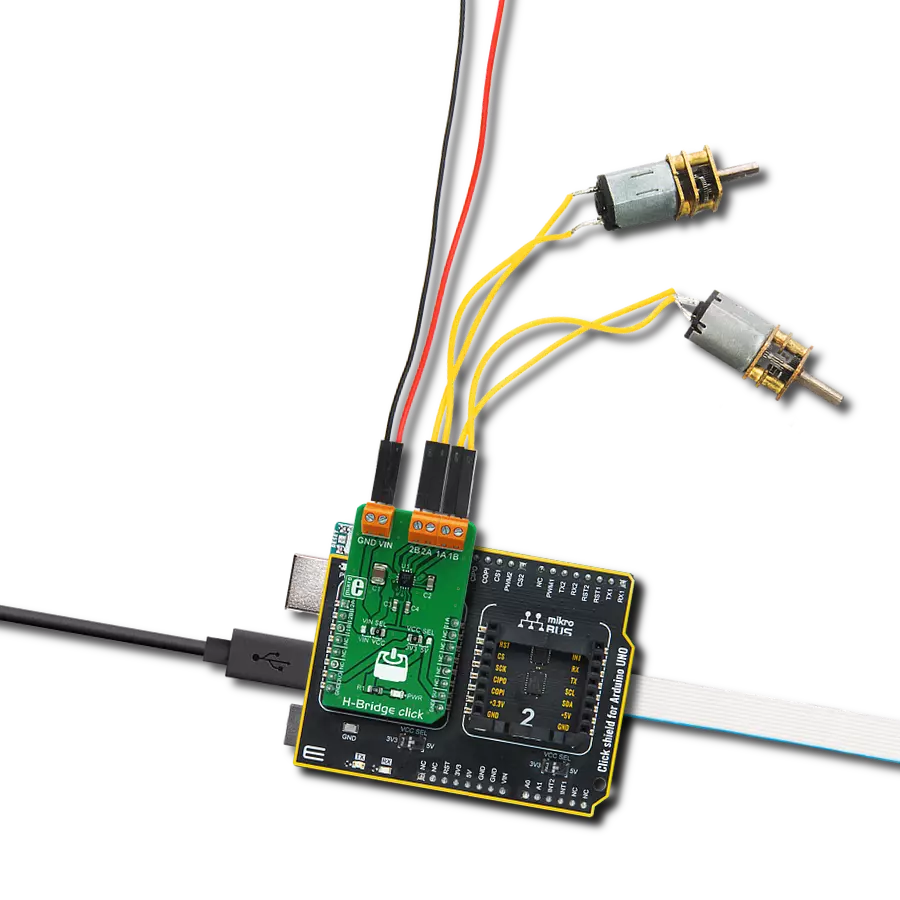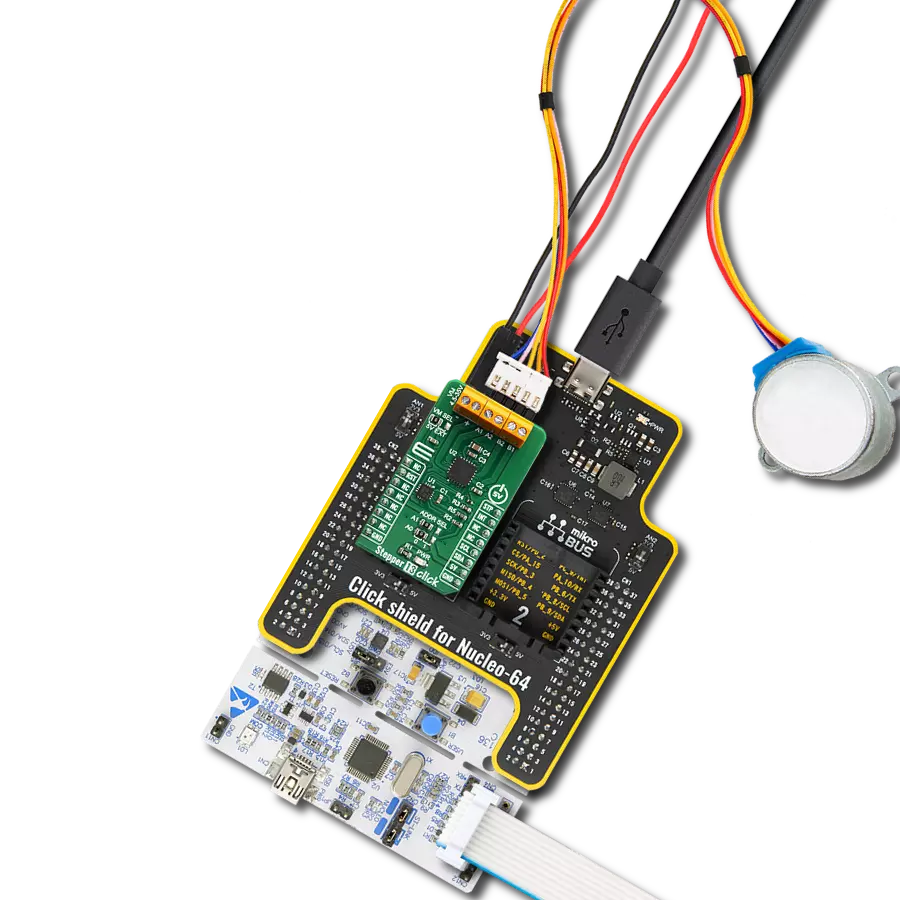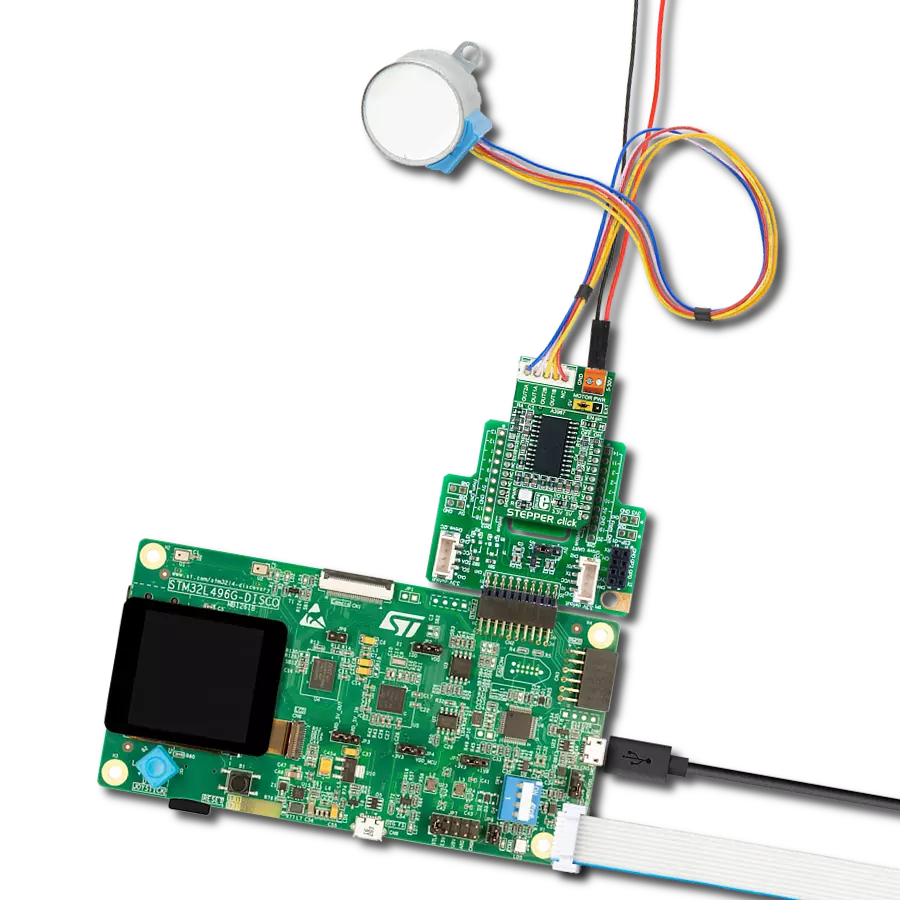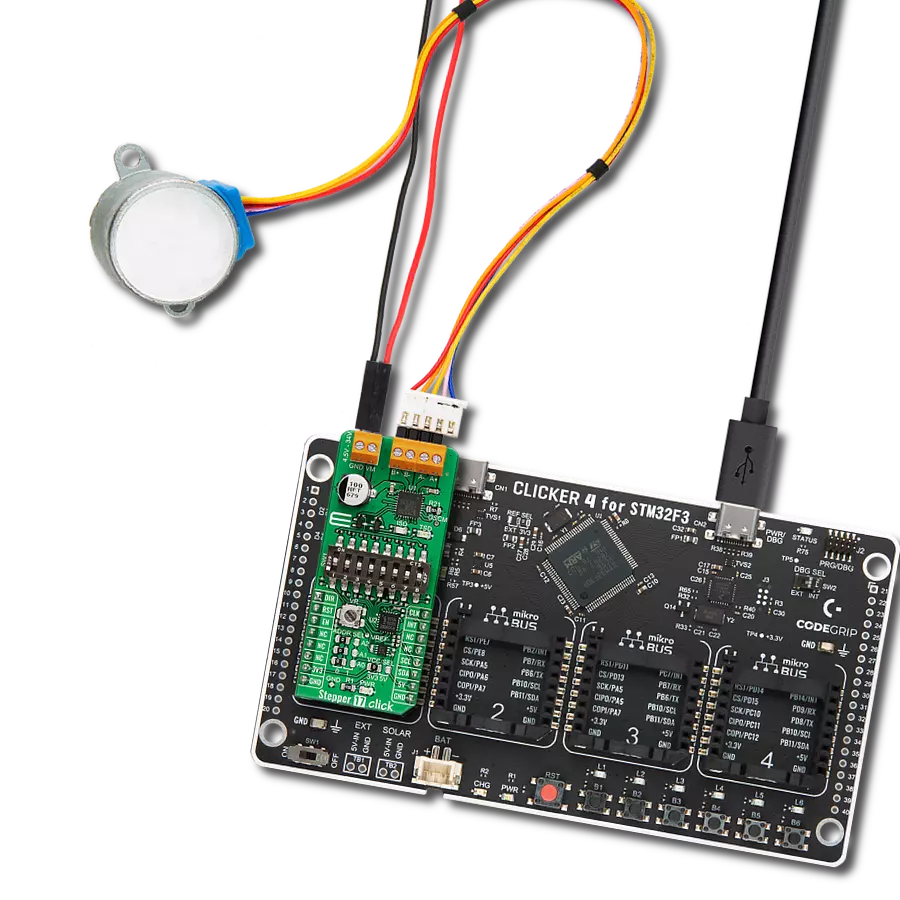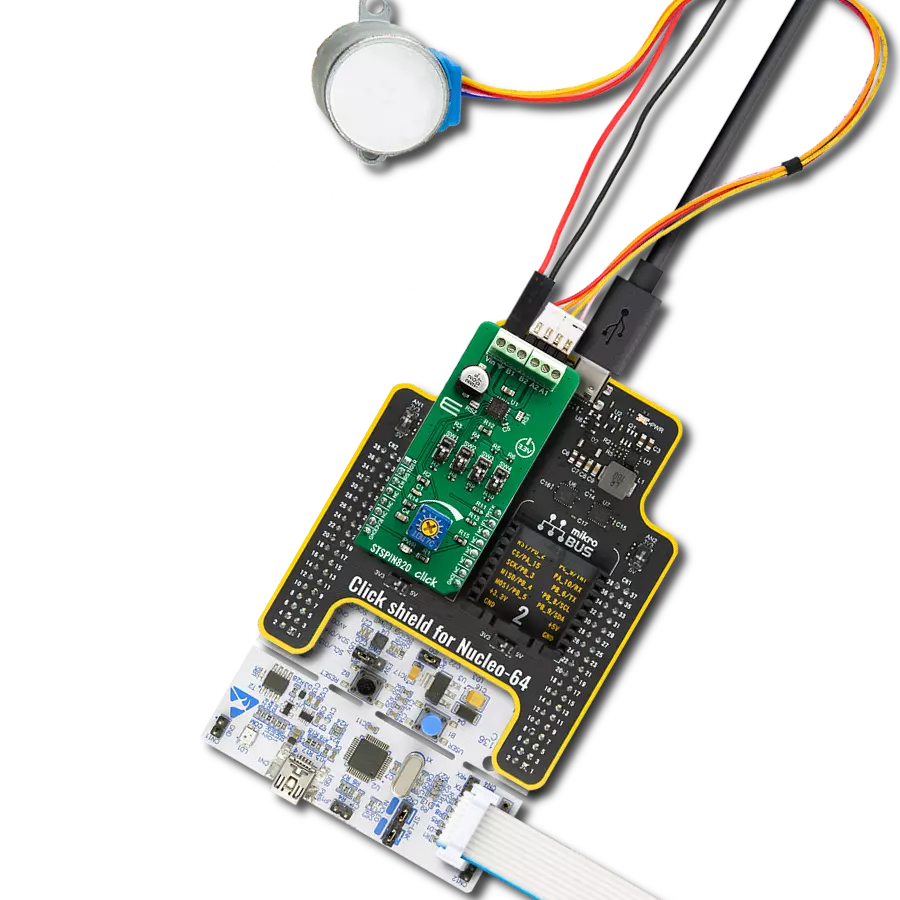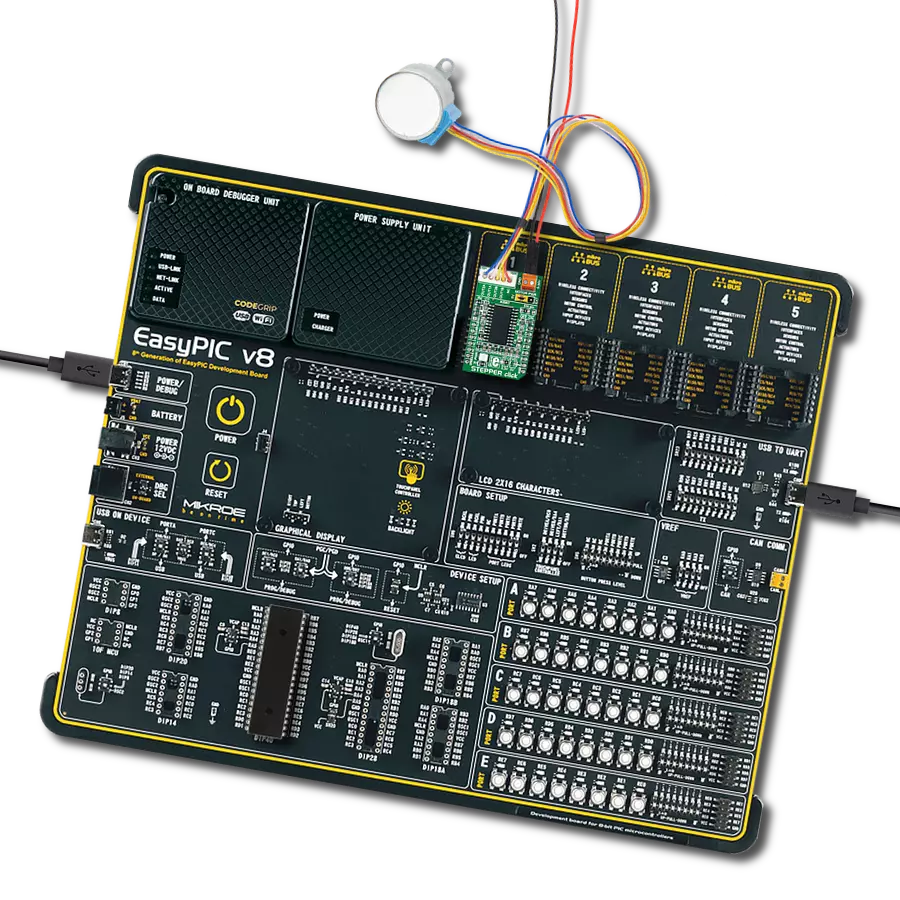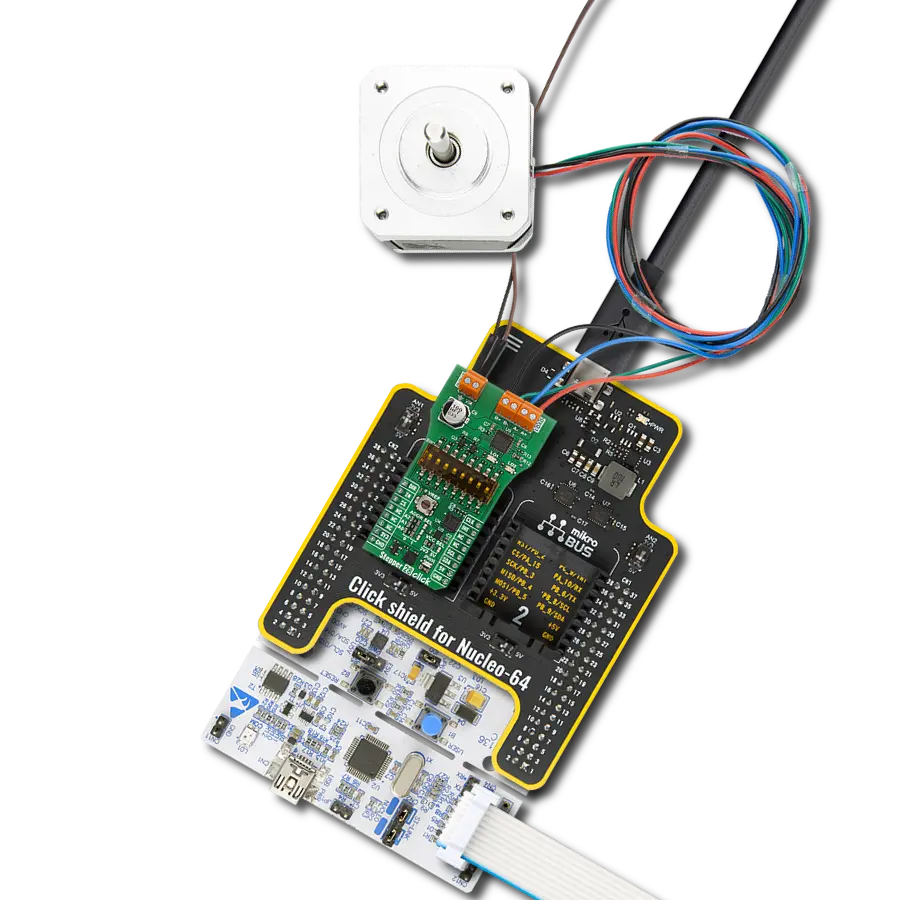Our innovative solution features seven integrated high-current drivers, offering a versatile platform for driving various loads and enabling your creative breakthroughs.
A
A
Hardware Overview
How does it work?
Driver Click is based on the DRV777, an integrated motor and relay driver from Texas Instruments. This IC has seven integrated current sink drivers. Each channel has a free-wheeling diode, connected to a common pin (COM) used for an inductive kickback voltage protection. This kickback voltage is typically observed at electromotors and relays, so the existence of such a protection makes this driver a good choice for driving motors, relays, and other inductive loads, which can generate back EMF. Each output is controlled by an input pin. Logic HIGH level on the input will result in the LOW state of the corresponding output, allowing a single driver to sink up to 140mA. The input logic voltage level can range between 1.8V and 5V, thus allowing a wide range of MCUs to be used. The input stage is filtered through an RC snubber filter, allowing the Click board™ to be used in a noisy environment. Logic LOW on the input pin will set the output
driver to a HIGH logic level, allowing up to 16V (20V absolute maximum) between the pin and the ground. While in a HIGH state, the output driver will not sink current. For this reason, the input is equipped with the weak pull-down resistor, allowing inputs to be left floating or tri-stated, ensuring that the output drivers will not accidentally drive the connected load. The output drivers are capable of sinking up to 140mA per channel. However, the DRV777 IC allows outputs to be used in parallel, combining the current that can be sink. This allows sinking up to 1A of current when all the drivers are combined. In addition, more Click board™ can be combined, allowing sinking even more current. This Click board™ is equipped with the nine-pole spring terminal. Each output is routed to the terminal, with the addition of the COM pin and GND. This pin is a common cathode pin for all the free-wheeling diodes and a special care should be taken to connect this pin to
the same voltage potential as the connected load. If not connected, a permanent damage might occur to the output drivers. GND for the load should be connected to the GND input of the nine-pole spring terminal. By using the output connector, various connections can be implemented with the same Click board™. Drivers can drive relays, motors, or a combination of these. The DRV777 datasheet offers several connecting and driving solutions. It also offers more in-depth information about the IC itself. Although the IC uses only the 5V power rail from the mikroBUS™, the Driver click can be freely interfaced to either 3.3V or 5V MCUs. It does not require a special jumper for the logic voltage level selection. However, it has two SMD jumpers labeled as IN6 and IN7, used to enable or disable these driver inputs. It is done so to prevent interference with the UART module in some cases, as these two pins are routed to the mikroBUS™ RX and TX pins.
Features overview
Development board
Nucleo-64 with STM32G474R MCU offers a cost-effective and adaptable platform for developers to explore new ideas and prototype their designs. This board harnesses the versatility of the STM32 microcontroller, enabling users to select the optimal balance of performance and power consumption for their projects. It accommodates the STM32 microcontroller in the LQFP64 package and includes essential components such as a user LED, which doubles as an ARDUINO® signal, alongside user and reset push-buttons, and a 32.768kHz crystal oscillator for precise timing operations. Designed with expansion and flexibility in mind, the Nucleo-64 board features an ARDUINO® Uno V3 expansion connector and ST morpho extension pin
headers, granting complete access to the STM32's I/Os for comprehensive project integration. Power supply options are adaptable, supporting ST-LINK USB VBUS or external power sources, ensuring adaptability in various development environments. The board also has an on-board ST-LINK debugger/programmer with USB re-enumeration capability, simplifying the programming and debugging process. Moreover, the board is designed to simplify advanced development with its external SMPS for efficient Vcore logic supply, support for USB Device full speed or USB SNK/UFP full speed, and built-in cryptographic features, enhancing both the power efficiency and security of projects. Additional connectivity is
provided through dedicated connectors for external SMPS experimentation, a USB connector for the ST-LINK, and a MIPI® debug connector, expanding the possibilities for hardware interfacing and experimentation. Developers will find extensive support through comprehensive free software libraries and examples, courtesy of the STM32Cube MCU Package. This, combined with compatibility with a wide array of Integrated Development Environments (IDEs), including IAR Embedded Workbench®, MDK-ARM, and STM32CubeIDE, ensures a smooth and efficient development experience, allowing users to fully leverage the capabilities of the Nucleo-64 board in their projects.
Microcontroller Overview
MCU Card / MCU
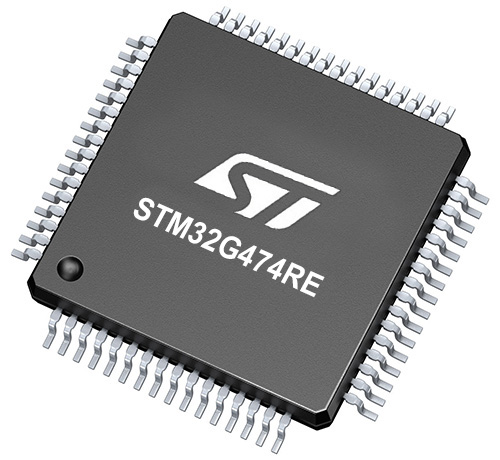
Architecture
ARM Cortex-M4
MCU Memory (KB)
512
Silicon Vendor
STMicroelectronics
Pin count
64
RAM (Bytes)
128k
You complete me!
Accessories
Click Shield for Nucleo-64 comes equipped with two proprietary mikroBUS™ sockets, allowing all the Click board™ devices to be interfaced with the STM32 Nucleo-64 board with no effort. This way, Mikroe allows its users to add any functionality from our ever-growing range of Click boards™, such as WiFi, GSM, GPS, Bluetooth, ZigBee, environmental sensors, LEDs, speech recognition, motor control, movement sensors, and many more. More than 1537 Click boards™, which can be stacked and integrated, are at your disposal. The STM32 Nucleo-64 boards are based on the microcontrollers in 64-pin packages, a 32-bit MCU with an ARM Cortex M4 processor operating at 84MHz, 512Kb Flash, and 96KB SRAM, divided into two regions where the top section represents the ST-Link/V2 debugger and programmer while the bottom section of the board is an actual development board. These boards are controlled and powered conveniently through a USB connection to program and efficiently debug the Nucleo-64 board out of the box, with an additional USB cable connected to the USB mini port on the board. Most of the STM32 microcontroller pins are brought to the IO pins on the left and right edge of the board, which are then connected to two existing mikroBUS™ sockets. This Click Shield also has several switches that perform functions such as selecting the logic levels of analog signals on mikroBUS™ sockets and selecting logic voltage levels of the mikroBUS™ sockets themselves. Besides, the user is offered the possibility of using any Click board™ with the help of existing bidirectional level-shifting voltage translators, regardless of whether the Click board™ operates at a 3.3V or 5V logic voltage level. Once you connect the STM32 Nucleo-64 board with our Click Shield for Nucleo-64, you can access hundreds of Click boards™, working with 3.3V or 5V logic voltage levels.
Used MCU Pins
mikroBUS™ mapper
Take a closer look
Click board™ Schematic

Step by step
Project assembly
Software Support
Library Description
This library contains API for Driver Click driver.
Key functions:
driver_set_in1- IN1 Set function.driver_set_in2- IN2 Set function.driver_set_in3- IN3 Set function.
Open Source
Code example
The complete application code and a ready-to-use project are available through the NECTO Studio Package Manager for direct installation in the NECTO Studio. The application code can also be found on the MIKROE GitHub account.
/*!
* \file
* \brief Driver Click example
*
* # Description
* This application offering a nine-pole spring terminal that can be used to implement and realize a wide range of different applications.
*
* The demo application is composed of two sections :
*
* ## Application Init
* Initializes GPIO driver and selects which inputs will be set in operation.
Bits from 0 to 6 (selectIN) select inputs from IN1 to IN7, respectively.
*
* ## Application Task
* Performs cycles in which selected inputs will be turned on for pulseWidth
delay time one by one. When one input is turned on, it will be turned off after desired delay time before the next input be turned on.
*
* \author MikroE Team
*
*/
// ------------------------------------------------------------------- INCLUDES
#include "board.h"
#include "log.h"
#include "driver.h"
// ------------------------------------------------------------------ VARIABLES
static driver_t driver;
static log_t logger;
// ------------------------------------------------------ APPLICATION FUNCTIONS
void application_init ( void )
{
log_cfg_t log_cfg;
driver_cfg_t cfg;
/**
* Logger initialization.
* Default baud rate: 115200
* Default log level: LOG_LEVEL_DEBUG
* @note If USB_UART_RX and USB_UART_TX
* are defined as HAL_PIN_NC, you will
* need to define them manually for log to work.
* See @b LOG_MAP_USB_UART macro definition for detailed explanation.
*/
LOG_MAP_USB_UART( log_cfg );
log_init( &logger, &log_cfg );
log_info(&logger, "---- Application Init ----");
// Click initialization.
driver_cfg_setup( &cfg );
DRIVER_MAP_MIKROBUS( cfg, MIKROBUS_1 );
driver_init( &driver, &cfg );
}
void application_task ( void )
{
uint8_t select_in;
uint8_t temp;
uint8_t count;
select_in = 0x7F;
temp = 1;
for (count = 0; count < 7; count++)
{
switch ( select_in & temp )
{
case 0x01 :
{
driver_set_in1( &driver, ENABLE_IN );
log_printf( &logger, "OUT1 enabled\r\n" );
Delay_ms ( PULSE_WIDTH );
driver_set_in1( &driver, DISABLE_IN );
log_printf( &logger, "OUT1 disabled\r\n" );
break;
}
case 0x02 :
{
driver_set_in2( &driver, ENABLE_IN );
log_printf( &logger, "OUT2 enabled\r\n" );
Delay_ms ( PULSE_WIDTH );
driver_set_in2( &driver, DISABLE_IN );
log_printf( &logger, "OUT2 disabled\r\n" );
break;
}
case 0x04 :
{
driver_set_in3( &driver, ENABLE_IN );
log_printf( &logger, "OUT3 enabled\r\n" );
Delay_ms ( PULSE_WIDTH );
driver_set_in3( &driver, DISABLE_IN );
log_printf( &logger, "OUT3 disabled\r\n" );
break;
}
case 0x08 :
{
driver_set_in4( &driver, ENABLE_IN );
log_printf( &logger, "OUT4 enabled\r\n" );
Delay_ms ( PULSE_WIDTH );
driver_set_in4( &driver, DISABLE_IN );
log_printf( &logger, "OUT4 disabled\r\n" );
break;
}
case 0x10 :
{
driver_set_in5( &driver, ENABLE_IN );
log_printf( &logger, "OUT5 enabled\r\n" );
Delay_ms ( PULSE_WIDTH );
driver_set_in5( &driver, DISABLE_IN );
log_printf( &logger, "OUT5 disabled\r\n" );
break;
}
case 0x20 :
{
driver_set_in6( &driver, ENABLE_IN );
log_printf( &logger, "OUT6 enabled\r\n" );
Delay_ms ( PULSE_WIDTH );
driver_set_in6( &driver, DISABLE_IN );
log_printf( &logger, "OUT6 disabled\r\n" );
break;
}
case 0x40 :
{
driver_set_in7( &driver, ENABLE_IN );
log_printf( &logger, "OUT7 enabled\r\n" );
Delay_ms ( PULSE_WIDTH );
driver_set_in7( &driver, DISABLE_IN );
log_printf( &logger, "OUT7 disabled\r\n" );
break;
}
default :
{
break;
}
}
log_printf( &logger, "----------------------\r\n" );
temp <<= 1;
Delay_ms ( 1000 );
}
}
int main ( void )
{
/* Do not remove this line or clock might not be set correctly. */
#ifdef PREINIT_SUPPORTED
preinit();
#endif
application_init( );
for ( ; ; )
{
application_task( );
}
return 0;
}
// ------------------------------------------------------------------------ END
Additional Support
Resources
Category:Stepper



















